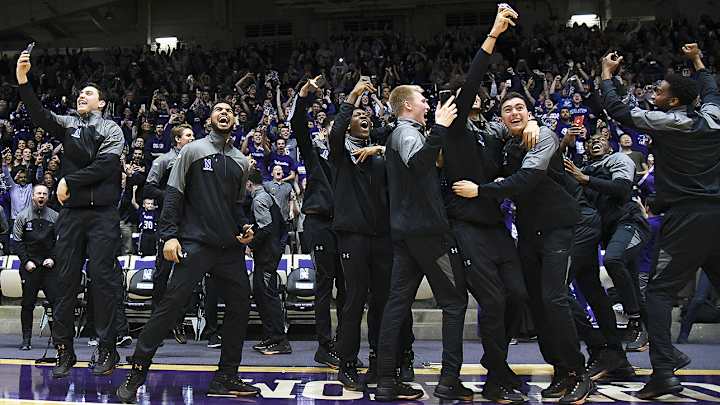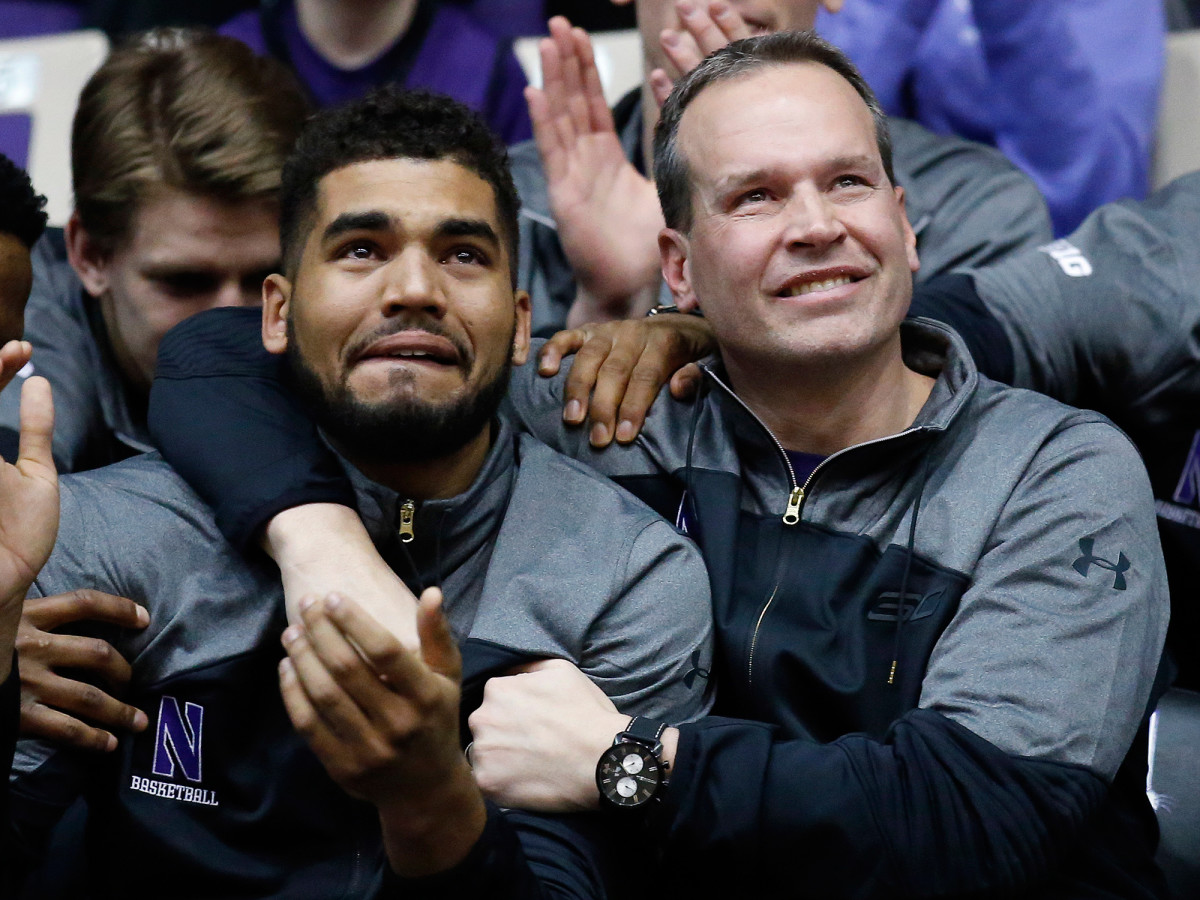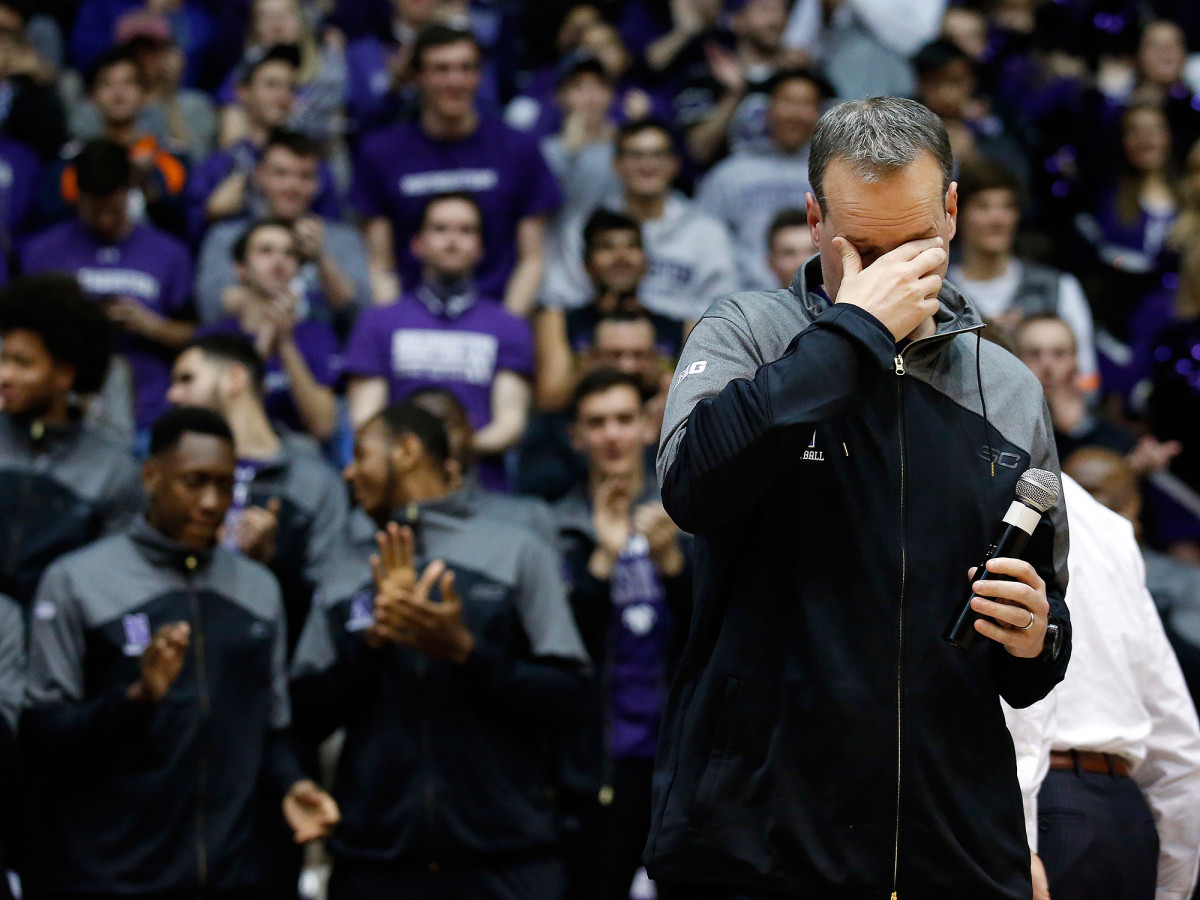Its tournament dreams finally realized, Northwestern ready to enter new era

EVANSTON, Ill. — At three minutes past 5 p.m. on March 12, 2017, Northwestern became an NCAA tournament team for the first time. Naturally there was a wait involved. A total of 50 programs took their assigned positions on a bracket line before the first few pixels of a purple strip appeared on a television graphic and instantly overwhelmed 78 years of sad and sundry failures. The ensuing cathartic roar from the crowd at Welsh-Ryan Arena made a respectable run at tearing the place down, a mega-million-dollar renovation project be damned. It brought everyone to their feet and brought a good number to tears. A couple thousand souls attended the watch party for a moment decades in the making, and while no one had ever seen this before, what you had here sure felt like a revival.
Chris Collins, the head coach who finished his high school career here and dreamed of this day when he walked back into the dated old gym 22 years later, threw his head back and screamed when Northwestern’s name appeared. He fell into the arms of Bryant McIntosh, the team’s point guard recording an unofficial assist by keeping a delirious 42-year-old upright. The players then swarmed for a suffocating group hug, gyrating and snapping selfies as their celebration was broadcast to the nation. McIntosh split off and found Vic Law and Scottie Lindsey, the other members of a junior class that underwrote this scene, and the trio locked arms and bounced in celebration of blind faith rewarded.
Five takeaways from the NCAA tournament bracket reveal
The slotting as the eighth seed in the last region to be filled extended the anxiety longer than preferable—“That was torture,” school president Morton Schapiro deadpanned when he addressed the masses—but it was the triumph of Sunday that matters of if became matters of when. A program with a history of crumbling at the first bad thing to happen survived multiple bad things this winter. And though Collins spent the last three months insisting nothing was guaranteed, the day suggested otherwise. Or his roster’s sartorial choices did, anyway: The Wildcats watched in gray and black warmups and then, after their fate had been sealed, unzipped the tops to reveal a T-shirt as presumptuous as it was purple.
IT’S TIME, it read.
“For a while, you question if you’re ever going to be a part of it,” McIntosh said. “Now, to see our name pop up on the video board…I’m speechless.”
It was time, at last, to stop considering the plight. It was time to celebrate, to talk about ticket sales and first-round opponent Vanderbilt, to a consider a question no one around here ever considered before: How do you dance when your feet aren’t touching the ground?
*****
Just before 2 p.m., the black GMC Denali turned into the long driveway and stopped a few feet before its intended destination. It was a hilariously poetic moment: The head coach of the Northwestern men’s basketball team couldn’t get into his parking spot on Selection Sunday.
Blocking the way? A satellite truck on site to record the greatest moment in program history.
“Beautiful day!” Chris Collins said after finding room two spaces over. Aside from the unseasonably chilly temperatures, there was no reason to be shaking on this afternoon. Following a Big Ten tournament semifinal loss to Wisconsin on Saturday and a late flight home from Dulles International Airport, Collins walked into his house well after midnight and slept in, all the way to 8:30 a.m. His family was still crashed out from the travel, so the Wildcats coach enjoyed a cup of coffee and a bowl of Cheerios in peace. He then headed to the basement for an elliptical machine workout and watched bits of the Ivy League and Atlantic 10 championship games. This was not the moment to be serious. The coach who went to 16 NCAA tournaments in 17 years as a Duke assistant knew that would come soon enough. “I want to enjoy today,” Collins said, before the festivities began in earnest. “Once we find out, we’ll lock in on what we want to do. But to me, today is a celebration.”
Enter Here

Cousin Sal Bets The House
Fill out a perfect bracket, win Cousin Sal’s L.A.-area home.
He hadn’t walked 20 steps from his car before he received reminders he didn’t need. A woman on her way into the watch party stopped Collins, informing him that she had a cheerleader daughter who had attended Northwestern and that his guys were, in her estimation, awesome. Collins shook her hand and told her it’s been a fun year. And after a quick post-arrival television interview outside, the coach’s trip to the front door of the arena was interrupted by a man wearing a purple cape and a Yankees hat.
Frank Orlandino has been coming to Northwestern basketball games for 35 years, the sort of regular fan who comes to Meet The Team nights in the preseason and gets Chris Collins to sign a poster for his barber. Three days after attending that meet-and-greet last fall (and, in fact, securing an autographed poster for his barber), the 69-year-old from suburban Franklin Park was diagnosed with prostate cancer. A friend who works at the school passed word along to the basketball offices. Upon hearing the news, Collins penned a handwritten letter to Orlandino, referring to the program’s “Pound the Rock” motto and encouraging Orlandino to fight through the bad days, to keep hammering away. Eventually, one day, the rock breaks.
Orlandino had the letter laminated and read it through 10 weeks of radiation and chemotherapy sessions that started at 5:30 a.m. Now, on Selection Sunday, he handed the letter to Collins. He told Northwestern’s coach he hoped it would offer even a little bit of help in any tough times to come. “That note is what everything’s about,” Orlandino said, “Today, tomorrow, Thursday, Friday.”
Collins happily took the letter but promised he’d return it soon. So good to have you here, the Northwestern coach told Orlandino. A special day, he told a longtime fan who didn’t even attend the school. “All the wins and losses are awesome, but that’s what makes coaching great,” Collins said later.
• NCAA tournament region breakdowns: East | West | South | Midwest
Days like Sunday do, too, if we’re being honest and realistic. But even this first NCAA tournament bid was a product of many small moments building upon each other, in contrast to 70-plus years of one moment jarring out of place and causing the entire stack to collapse, forcing everyone to start building all over again.
It was April 1, 2013, when Collins flew to Chicago one day after Duke lost a regional final game to Louisville. He rode directly from the airport to Pete Miller’s Steakhouse, a fixture in downtown Evanston. There, six days after being named Northwestern’s coach and just hours before his official introductory press conference, Collins met his new team for the first time over dinner in a private room just off the bar area. The first-time head coach told everyone they had a clean slate and that he wanted to grow together and build something special.
Among the attendees that night was Sanjay Lumpkin, a forward from Wayzata, Minn., who had redshirted during the 2012–13 season. “I knew instantly things around here were going to be different,” Lumpkin said, recalling the tenor of the evening. Lumpkin idolized Drew Crawford, his roommate and a stalwart senior who faced a choice: Play his fifth year of eligibility elsewhere or stick around and help Collins begin to craft a culture, even though wins were not likely to be plentiful in his final college season. Whatever message Collins sent early on, Crawford bought; even on Sunday, Collins called Crawford one of the most important recruits in his brief tenure in Evanston. Without Crawford and his 15.7 points per game, that first year would’ve been a disaster. As it was, a 14-victory campaign at least set a feasible trajectory.
Four years later, Northwestern reached the NCAA tournament thanks to the example set by another indefatigable fifth-year senior: Lumpkin, who averaged just 6.1 points and 5.6 rebounds but nevertheless earned the distinction of being the team’s “rock,” per its head coach. Because Collins sent a convincing message beginning at Pete Miller’s, Drew Crawford stayed aboard. And because Drew Crawford stayed aboard, Sanjay Lumpkin had an example to follow. One moment leading inextricably to the next. “Every season, we’ve gotten better,” Lumpkin said. “Everyone is trusting him; it wouldn’t work without trust. Every year, we’ve seen progress, we’ve seen steps, and it gives guys more reason to believe we can be a great team. We know he came here for the same reason why a lot of us came here, to make this a different program. I know that’s why I came here. To be a part of something bigger than myself.”

It wasn’t easy, Lumpkin notes. But then at Northwestern, it never is.
The dynamic extends beyond Collins setting early morning workouts to test the mettle of his new players in 2013. (For the first few, they didn’t even touch a ball, focusing entirely on defense.) The program has at least flirted with NCAA tournament possibility before. But at the most hopeful moments, disaster struck. The 2010–11 team, for example, was a 20-win outfit that earned the third of four straight NIT bids. It might have been destined for more behind the play of junior forward John Shurna, who averaged 23.3 points in his first 10 games…before rolling an ankle and missing essentially half the season. In the case of postseason-starved Northwestern, bad things always came to those who wait.
So it was this season that forward Aaron Falzon, a 29-game starter in 2015–16, would miss the entire year with a knee injury. So it was that center Dererk Pardon, an essential, rugged interior presence, would break his hand against Wake Forest in December and miss eight games, including the start of the Big Ten season. But nothing would compare to the call Collins received at 8 p.m. on Jan. 30, following a walk through after an 13-point home win over Indiana, the program’s sixth in a row.
For a few days, Scottie Lindsey couldn’t shake the cold he’d been battling. Northwestern’s leading scorer and one of its top individual defenders had a sore throat, too, so he figured at worst he had strep throat and some antibiotics would knock it out in time for an impending showdown at Purdue. The team’s medical staff nonetheless had Lindsey take a blood test. When they received the results, they called Collins, who knew a late-night call from a trainer was never good. And it wasn’t: Lindsey had mononucleosis. He had to miss a mandatory three weeks. And during that period, to protect a spleen made vulnerable by the virus, Lindsey could partake in exactly zero basketball activity.
The curious case of West Virginia: Do analytics back a deep tourney run?
“I couldn’t believe it,” Lindsey said. “I was like, why would this happen now? We’re literally so close to doing everything we want to do.”
It happened because these things always happen at Northwestern. But here is what didn’t happen: Disastrous collapse. The Wildcats lost three of four without Lindsey in the lineup…but the one win was a 66–59 victory at then-No. 7 Wisconsin. The magnitude of that result alone helped the team maintain some NCAA tournament equilibrium. Another spate of three losses in four games inspired more teeth-grinding, but Northwestern would subsequently notch the now-famous March 1 win over Michigan, in which Pardon caught a full-court heave from senior Nate Taphorn to score at the buzzer and seal a victory that all but sealed the NCAA tournament fate.
The things that go wrong at Northwestern once again went wrong. But Northwestern, this time, this year, didn’t lose its way. The Wildcats instead found their way again, authoring a miracle finish for good measure, a path that led to the first few rows of a section of arena seats and a view of a mammoth video screen that declared them a participant in the NCAA tournament. The catastrophes came and went, as ever. And Northwestern wound up exactly where it wanted to be.
“We’ve had to figure it out on the fly all year long,” Collins said. “We stayed tough. We faced pressure. We faced adversity. These guys never quit. They stayed resilient through it all and found a way to win enough.
“I told them all year long, you get what you deserve. I thought we got exactly what we deserved.”
*****
The upper-level seating area on the north side of Welsh-Ryan Arena has been stripped of bleachers and chairs already. When Northwestern emerged from the locker room just before 3:30 on Sunday for a team meal—cold cut sliders, pasta salad and wings were the highlights, with Simply Lemonade and Arizona sweet tea available to wash it down—it dined near walls featuring patches of exposed glue. Whatever was hanging from them had been ripped off unceremoniously. The long overdue, $110 million, 18-month renovation of the building had begun before this basketball season was technically over. “We’re just getting started here,” Northwestern athletics director Jim Phillips said late Sunday.
When Collins began selling recruits on the place, he admitted he had nothing tangible to show them. No banners. No pro players he’d tutored along the way. He’d never called a timeout or made a substitution as a head coach. Trust me, was all he could tell them. Believe in me. Believe in this. But now there were many millions going into a new home that will open for the 2018–19 season and still more millions going into a practice facility next door. Wall décor to replace the glue stains is presumably still TBD. But as of 5:03 p.m. Sunday, at least Northwestern knows what it will hang from the ceiling.
“To me, this isn’t the end game,” Collins told the watch party crowd, after fighting through tears when he took the microphone. “To me, this is the beginning of Northwestern basketball.”

This was a Sunday made for hyperbole, for unapologetic reverie without limit. A minute before 4 p.m., the Northwestern band struck up with its first tune of the day: Walk the Moon’s “Shut Up and Dance.” Seventeen minutes later, the team filed out one by one, from the managers to the backups to the regulars and finally Collins, and then they waited just a little longer for CBS to drop them in a bracket and confirm that dreams do come true. (“It seemed really hot in that building for 45 minutes,” Collins cracked later.) And after hugs with each other and handshakes with fans leaving the stands, the players eventually made their way to the club room upstairs to the discuss their breakthrough, though they’d made a wardrobe change in between.
The Wildcats traded out their purple IT’S TIME shirts for a batch of white tops provided by Under Armour. The new duds featured Northwestern’s name in glittering gold lettering with yet another riotously presumptuous tag line: MARCH INTO APRIL.
“Is the championship game in April?” Vic Law asked, seemingly rhetorically.
It is. But this was a vision probably best to set aside for now. One moment that no one saw coming at a time.
